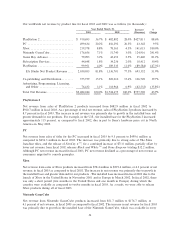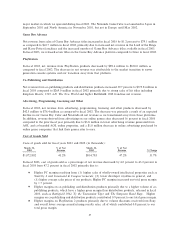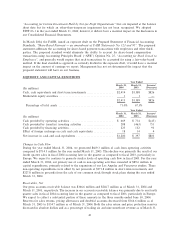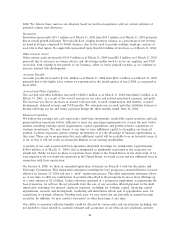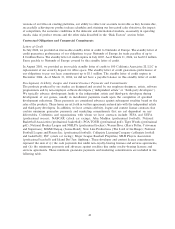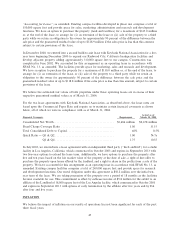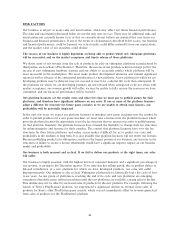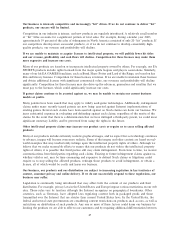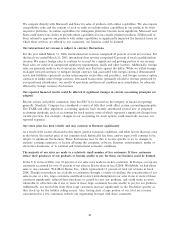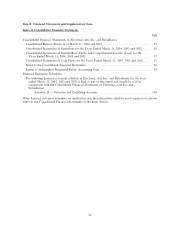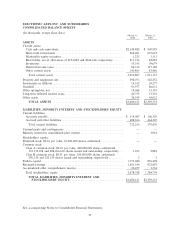Electronic Arts 2004 Annual Report Download - page 61
Download and view the complete annual report
Please find page 61 of the 2004 Electronic Arts annual report below. You can navigate through the pages in the report by either clicking on the pages listed below, or by using the keyword search tool below to find specific information within the annual report.
RISK FACTORS
Our business is subject to many risks and uncertainties, which may aÅect our future Ñnancial performance.
The risks and uncertainties discussed below are not the only ones we face. There may be additional risks and
uncertainties not currently known to us or that we currently do not believe are material that may harm our
business and Ñnancial performance. If any of the events or circumstances described below occurs, our business
and Ñnancial performance could be harmed, our actual results could diÅer materially from our expectations,
and the market value of our securities could decline.
The success of our business is highly dependent on being able to predict which new videogame platforms
will be successful, and on the market acceptance and timely release of those platforms.
We derive most of our revenue from the sale of products for play on videogame platforms manufactured by
third parties, such as Sony's PlayStation 2. Therefore, the success of our products is driven in large part by the
success of new videogame hardware systems and our ability to accurately predict which platforms will be
most successful in the marketplace. We must make product development decisions and commit signiÑcant
resources well in advance of the anticipated introduction of a new platform. A new platform for which we are
developing products may be delayed, may not succeed or may have a shorter life cycle than anticipated. If
the platforms for which we are developing products are not released when anticipated or do not attain wide
market acceptance, our revenue growth will suÅer, we may be unable to fully recover the resources we have
committed, and our Ñnancial performance will be harmed.
Our platform licensors set the royalty rates and other fees that we must pay to publish games for their
platforms, and therefore have signiÑcant inÖuence on our costs. If one or more of the platform licensors
adopt a diÅerent fee structure for future game consoles or we are unable to obtain such licenses, our
proÑtability will be materially impacted.
In the next few years, we expect our platform licensors to introduce new game machines into the market. In
order to publish products for a new game machine, we must take a license from the platform licensor which
gives the platform licensor the opportunity to set the fee structure that we must pay in order to publish games
for that platform. Similarly, the platform licensors have retained the Öexibility to change their fee structures
for online gameplay and features for their consoles. The control that platform licensors have over the fee
structures for their future platforms and online access makes it diÇcult for us to predict our costs and
proÑtability in the medium to long term. It is also possible that platform licensors will not renew our licenses.
Because publishing products for videogame consoles is the largest portion of our business, any increase in fee
structures or failure to secure a license relationship would have a signiÑcant negative impact on our business
model and proÑtability.
Our business is both seasonal and cyclical. If we fail to deliver our products at the right times, our sales
will suÅer.
Our business is highly seasonal, with the highest levels of consumer demand, and a signiÑcant percentage of
our revenue, occurring in the December quarter. If we miss this key selling period, due to product delays or
delayed introduction of a new platform for which we have developed products, our sales will suÅer
disproportionately. Our industry is also cyclical. Videogame platforms have historically had a life cycle of four
to six years. As one group of platforms is reaching the end of its cycle and new platforms are emerging,
consumers often defer game software purchases until the new platforms are available, causing sales to decline.
This decline may not be oÅset by increased sales of products for the new platform. For example, following the
launch of Sony's PlayStation2 platform, we experienced a signiÑcant decline in revenue from sales of
products for Sony's older PlayStation game console, which was not immediately oÅset by revenue generated
from sales of products for the PlayStation2 platform.
46


